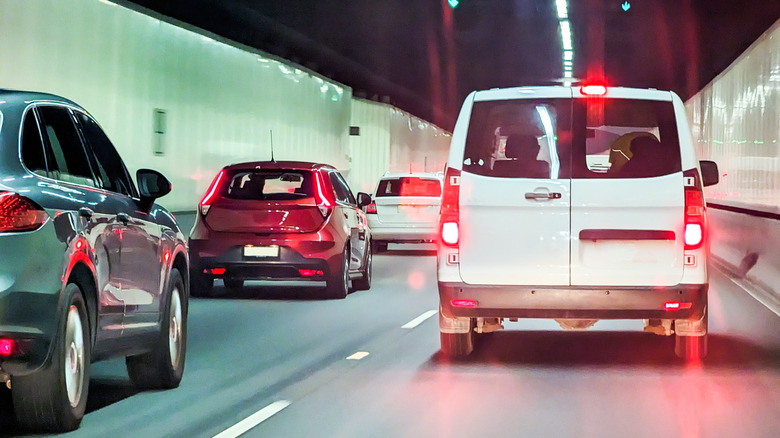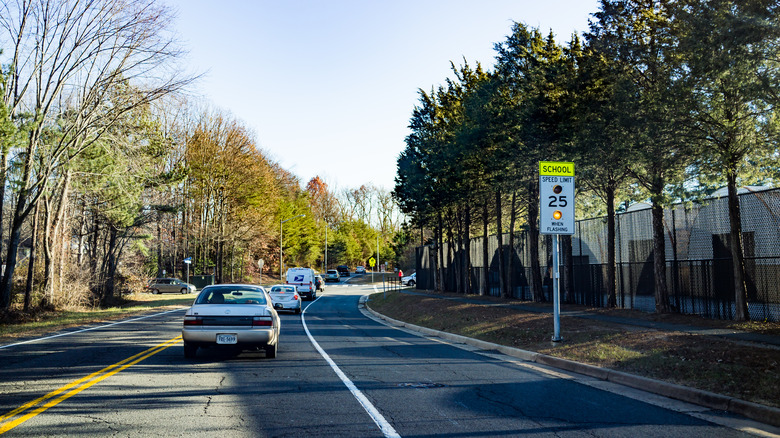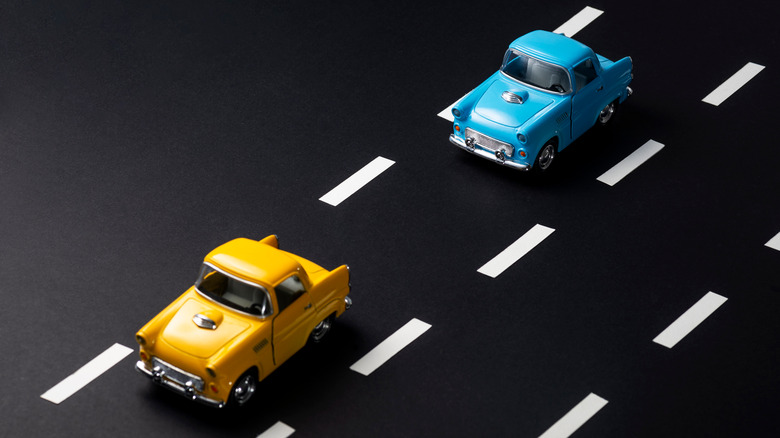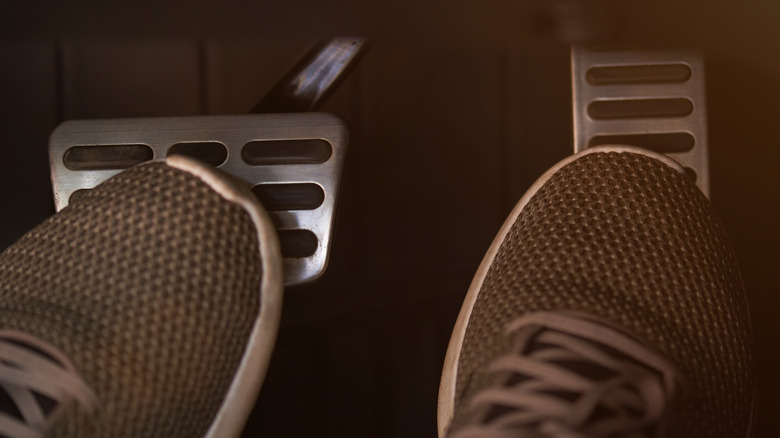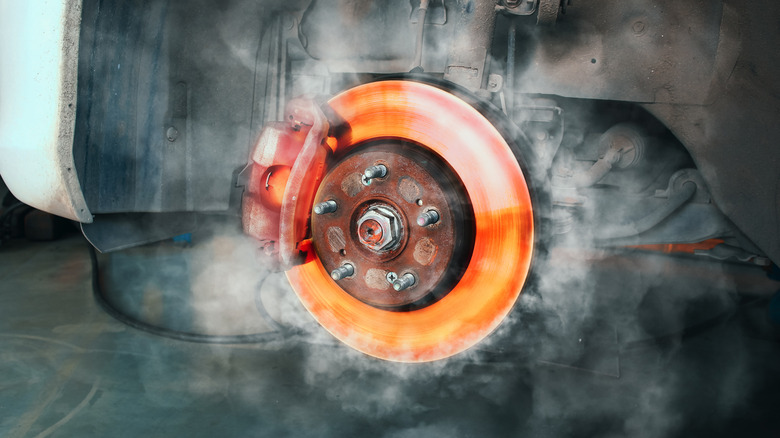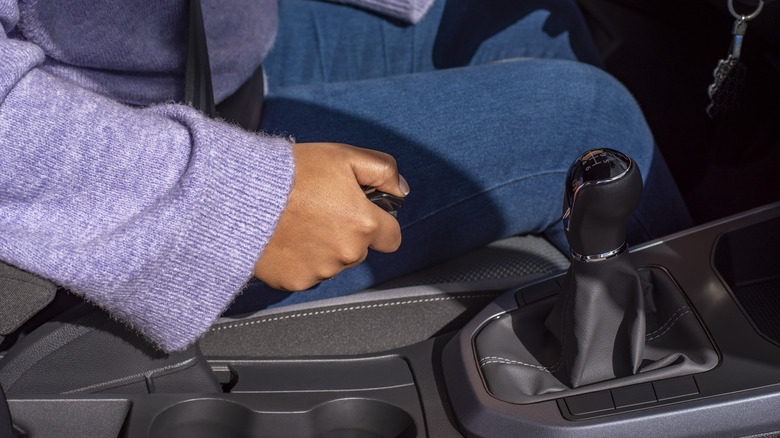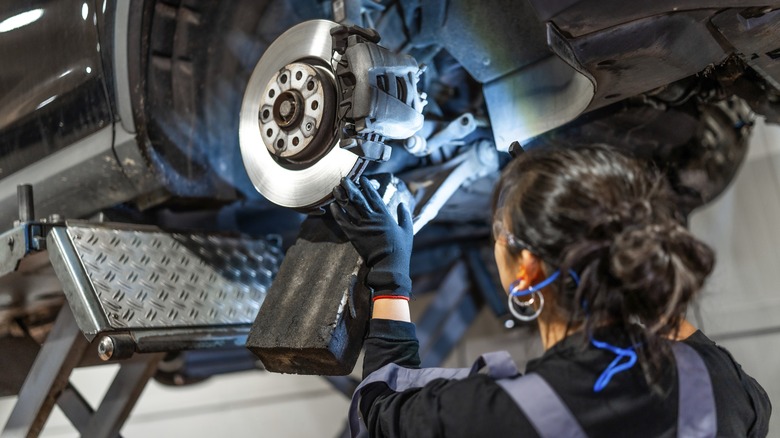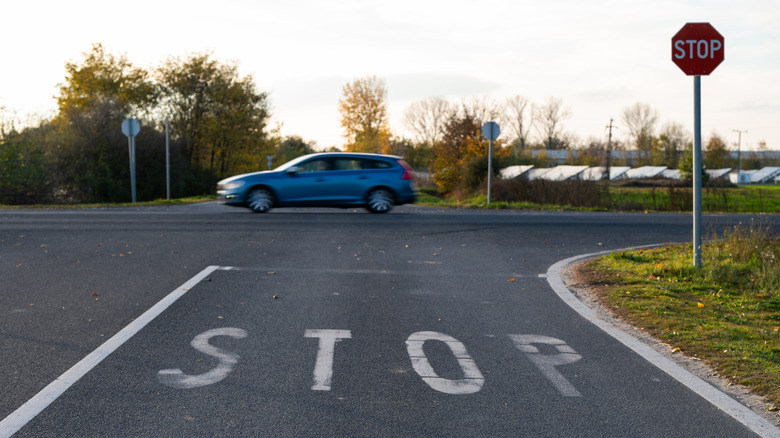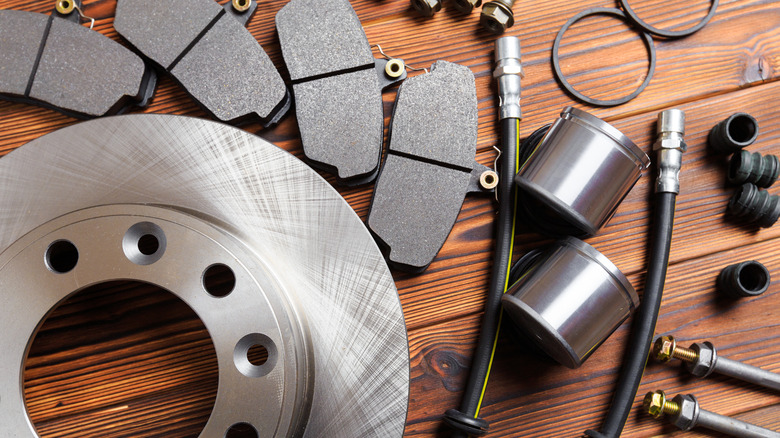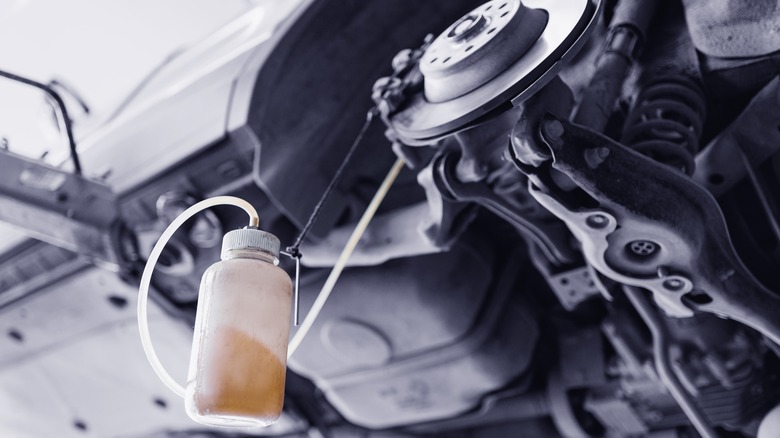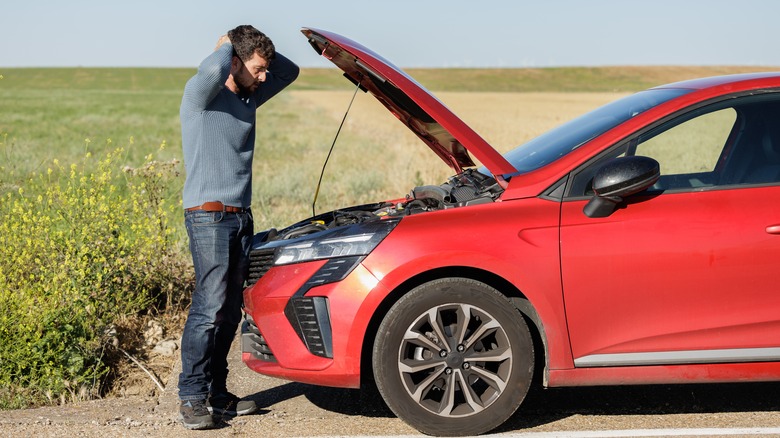12 Useful Tips For Lengthening The Lifespan Of Your Car's Brake Pads
You know that awful moment when your mechanic gives you that look and says, "Your brakes are shot"? Here's the dirty little secret: Those expensive replacements didn't have to happen so soon. The truth is that most drivers unknowingly grind their brake pads into dust with a handful of bad habits. But what if you could practically double your brake pads' lifespan with just a few tweaks to how you drive and maintain your car?
Don't worry, you won't have to cruise at a snail's pace or spend your weekends at the auto shop. In fact, the best tricks are so easy, you'll wonder why no one told you sooner. The funny thing is, once you start doing these things, your car will feel so much better to drive. You'll enjoy smoother stops, less stress in traffic, and the sweet, sweet satisfaction of knowing you're beating the system while everyone else gets surprise repair bills. Ready to become the brake pad genius your wallet deserves? Here's what you need to know.
Avoid riding the brakes
"Riding the brakes" means keeping your foot lightly resting on the brake pedal when you're not genuinely trying to stop. Maybe you're just resting your foot there out of habit, or you're nervous in heavy traffic and giving it just a tiny bit of pressure "just in case."
Sounds innocent enough, sure. But here's the problem: Even the lightest touch creates friction, and friction means heat and wear. It's like dragging a pencil eraser across paper all day long. Eventually, there's nothing left. Plus, your brake lights stay on constantly, which confuses the heck out of drivers behind you who can't tell when you're actually slowing down. And when you finally do brake for real, they might not even realize it.
The fix is stupidly simple but makes a huge difference. When you're not actively braking, move your foot completely away from the brake pedal. Don't worry, it only takes a fraction of a second to move your foot back when it matters. And the results are worth it. Your brake pads will instantly start lasting longer, and you'll stop being the driver with the brake lights always on. It's the easiest money you'll ever save on car repairs.
Start to slow down earlier
Does this sound familiar? A red light is a quarter mile away, but the car in front of you is still on the gas, only to slam on the brakes at the last possible second. What gives? That's like sprinting full speed toward a wall and then using all your strength to stop an inch away. Unnecessarily dramatic ... and exhausting.
Your brakes hate drama, too. Hard, last-minute stops crank up the heat and chew through your pads fast. But you know what happens even sooner? Brake pad glazing, where heat turns your pads slick and glossy, making them about as useful as an ice cube when you need to stop. Suddenly, what should feel like a smooth, confident braking experience feels soft, shaky, and just plain wrong.
The good news is that it doesn't have to be that way. If you're looking far enough ahead, you can ease off the gas long before you need to brake. The moment you spot that red light, brake lights ahead, or a school zone sign, just lift your foot off the gas and let physics do its thing. Your car will naturally start slowing down without any drama, and you can use gentle, gradual braking to fine-tune your stop.
Maintain safe following distances
How much do you really trust the driver ahead of you? Think about it ... Do you know if they're about to check their phone, suddenly slam on the brakes for a squirrel, or take an unexpected right turn with no signal? Probably not. So why ride their bumper like you're drafting for NASCAR? It pays to leave some space.
A good rule of thumb is the two- to four-second rule. Here's how it works: Pick something up ahead, like a streetlight or signpost, and when the car in front passes it, start counting: "one-Mississippi, two-Mississippi ..." If you pass that same spot before you finish your count, you're following too closely. In regular conditions, two seconds is the bare minimum. In rain, heavy traffic, or on the highway? Go for four or more.
Keeping this cushion gives you time to react calmly instead of slamming on your brakes in a panic. Your brake pads will love you for it, and honestly, so will your nerves. More space means fewer sudden stops, smoother braking, and a lot less wear on your brakes over time.
Only use one foot to drive
Unless you're tearing up an autocross course, driving with your left foot on the brake and your right foot on the gas isn't a good idea. So, if this is how you learned, it's time to break the habit. Sure, it might feel like you're being quick and ready for action, but here's the brutal truth: Two-foot driving is a brake pad massacre waiting to happen.
The problem is simple. When your left foot hovers over the brake pedal, it's far too easy to rest it there without even noticing. And what does that mean? That's right. You're riding the brakes. And then there's the panic factor. In a sudden stop, two-foot drivers often mash both pedals at once. The brakes will likely win, but at what cost?
Either way, you're forcing them to work way harder than they should, wearing down the brake pads quicker, and making every stop rougher than it needs to be. All that extra stress adds up fast, and so will your repair bills. The easy fix? Stick with one foot — your right foot — for driving. Let your left foot take a well-earned break. Or better yet, if your left foot really wants something to do, learn to drive a manual.
Cool down after hard braking
Sometimes you can't avoid giving your brakes a serious workout. Maybe you're crawling down a mountain road, stuck in brutal stop-and-go traffic, or you've had to make an emergency stop because some jerk decided to cut you off. When this happens, your brakes get seriously hot. And hot brakes are hungry brakes that gnaw through pads way faster than they should.
Worse yet, if you immediately hold the car still by pressing the brake pedal or engaging the parking brake, the super-hot pads clamp down on one spot of the fiery-hot metal rotor. This can cause the rotor to warp as it cools unevenly, leading to an annoying, shaky, vibrating feel when braking.
To avoid damaging your brake pads and rotors, simply give the parts a chance to chill out after any intense braking session. Drive gently for a few minutes — no hard accelerating or sudden stops, just easy cruising to let all that heat dissipate. Think of it as a cool-down period, like gently stretching after a workout. Your brakes will cool off, calm down, and stay in better shape for the long haul.
Always release the parking brake
You'd be amazed how many people cruise around town with their parking brake engaged, slowly roasting their rear brake pads and rotors without even knowing it. Maybe the release didn't quite work all the way, or perhaps you were distracted and forgot to even check. The tricky thing is that a partially stuck parking brake doesn't always announce itself loudly.
Sometimes your car just feels a little more sluggish than usual, like it's working extra hard to get moving. You might notice your gas mileage taking a nosedive or catch a whiff of something burning, but these signs are easy to ignore until you've done some serious damage.
You can avoid all that by always giving the parking brake a visual and physical check before you roll out. Sure, most cars will light up your dashboard if it's engaged, but don't put all your trust in the warning light. Give the handle or pedal a quick look to make sure it's completely released and sitting where it should be. It's such a simple check, but skipping it can cost you hundreds in premature brake wear. And don't forget to look things over whenever your car feels a bit off.
Do the whole brake job
Here's where a lot of people get penny-wise and pound-foolish. When it's time for brake work, there's always that temptation just to slap new pads on and call it a day. After all, the pads are what actually wear out, right? Wrong move. If your rotors are warped, scored up, or worn down, they're going to eat through those shiny new pads incredibly fast.
A proper brake job means checking and servicing the whole system, not just the pads. Are the rotors smooth and true, or do they need to be resurfaced or replaced? How are the calipers moving? Is the brake fluid clean? Are all the hardware pieces in good shape? Admit it ... Your car deserves a full checkup and proper care.
Yes, doing it right costs more upfront. But do the math, and you'll see that your wallet comes out ahead. Spending extra now to get rotors resurfaced or replaced means your new pads will last their full expected lifespan. Skipping that step means you might be replacing pads twice as often, which ends up costing way more in the long run.
Break in new pads properly
Fresh brake pads? Love that for you. But hold up, you can't just drive off like nothing's changed and expect perfect stops from day one. New pads need a proper "getting-to-know-you" phase with your rotors, also known as bedding in, where they learn to grip together just right.
Think about it this way: Your brake pads and rotors are meeting for the first time, and they need a little time to settle into a smooth, even relationship. If you jump straight into hard stops, you're basically forcing them into an awkward, rocky start, leading to uneven pad wear, annoying squeaks, and poor performance. And that means you'll need to replace your pads much sooner than expected.
So what's the move? Right after installation, take it easy and go through a few solid but controlled stops, just enough to get the pads and rotors warmed up together. And whatever you do, don't sit there with your foot clamped on the brake right afterward. Then, finish with a nice, leisurely cruise to let everything cool down gently. Do that right, and you're setting your brakes up for a long, happy life together.
Invest in quality brake parts
Yeah, those super-cheap brake pads at the discount auto store might look tempting, especially when you're staring at the price tag, but this isn't where you want to pinch pennies. Cheap pads might stop your car ... for a while ... but they wear out faster, tend to squeak and groan, and can even chew up your rotors if they're made from low-grade materials.
Quality brake parts, on the other hand? Total game-changer. Since they use better friction materials, high-quality brake pads last longer, stop more effectively, and are gentler on your rotors. They handle heat better, too, which means less fade when you need stopping power the most. But that doesn't mean you need the most expensive racing pads unless you're planning on some track days.
Instead, step up to mid-range pads from a reputable brand like EBC, Power Stop, or Akebono. Look for ceramic or premium semi-metallic pads if you want solid performance without going overboard. These offer better heat resistance, lower dust, and longer life than the bargain options, without being overkill for daily use.
Flush your brake fluid regularly
Want to know the brake maintenance step that almost everyone forgets about? Yep, brake fluid flushes. You know, that mysterious liquid hiding in the little reservoir under your hood that you probably haven't thought about since ... ever? Yeah, that stuff needs attention, and ignoring it could be costing you brake pad life.
Brake fluid is hygroscopic, which is a fancy way of saying it loves to suck up moisture from the air like a sponge. Over time, all that water contamination lowers the fluid's boiling point, making your brakes less effective and forcing you to press harder to get the same stopping power. And when you're pushing harder on the brake pedal, guess what's working overtime? Your brake pads.
Most manufacturers recommend changing brake fluid every two years or 30,000 miles, but plenty of people go way longer than that. Big mistake. Wait too long, and you'll be harshly reminded by a mushy brake pedal and little to no stopping power. And all the while, your brake pads will be wearing out faster than they should, so it's double trouble.
Pay attention to warning signs
Your car isn't shy. It loves to drop hints when your brakes aren't happy. Hear a squeal every time you stop? That's your brake pads saying, "Hey! We're getting thin over here!" Grinding? Uh-oh ... that's metal-on-metal and a clear sign you've waited too long. Feel a weird vibration or pulsing in the brake pedal? Could be warped rotors asking for attention. The key is not to turn up the radio and hope it goes away (tempting, sure).
Each little warning is your brakes waving a flag and giving you a chance to fix things before your pads get shredded or your rotors take a hit. By paying attention to the sounds, feel, and even smells your car is throwing your way, you can catch minor issues early, protect your brake pads, and avoid costly repairs. It's like giving your brakes a checkup when they ask for it, and you can bet they'll last longer and perform better because of it.
Lighten your load
Your brakes don't just stop your car. They stop everything you're carrying. That overstuffed trunk? Yep, your brakes feel every bit of it. Extra gear, sports equipment, tools you forgot were back there, bags of who-knows-what ... it's all added weight.
Every extra pound in your car makes your brakes work harder to bring all that weight to a stop. It's basic physics. More mass means more energy needed to stop, which means more friction, which means your brake pads wear out faster. Your car doesn't care if that extra weight is important stuff or just (literal) junk in your trunk.
Consider this your sign to finally clean out all that stuff you've been ignoring for months. Your brake pads will definitely appreciate the lighter load, and you'll probably be surprised by how much more responsive your car feels, too. As a bonus, you might finally discover where your phone charger, sunglasses, and missing water bottle have been hiding.
Treat your brakes right, and they'll return the favor
Brake pads don't ask for much. They just want some basic care and a few smart driving habits to protect them from premature wear and tear. So, what's this going to cost you? Not much, really. At the end of the day, most of these tips boil down to being a smoother, more predictable driver. By looking ahead, giving yourself space, and being gentle on your pedals, you do most of the work. Combine that with smart maintenance, like using quality parts and keeping your fluids fresh, and you've got the ultimate recipe for long-lasting brakes.
Remember, you don't have to be perfect. Even adopting just a few of these habits can extend your brake life considerably. Maybe you start by coasting more to red lights, or finally clearing out that trunk full of "just in case" junk. Small tweaks can truly lead to big savings. Think of it this way ... Every time you avoid a hard stop or catch a warning sign early, you're saving money. Best of all, you're making the road safer for yourself and everyone around you.

